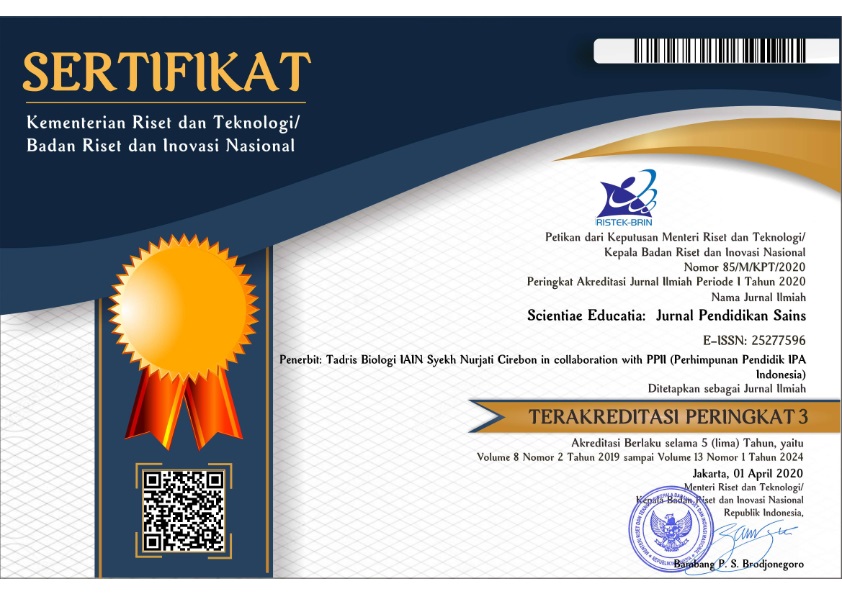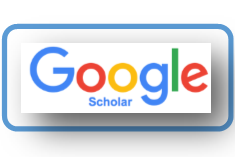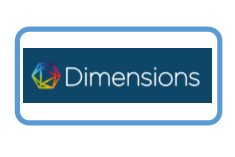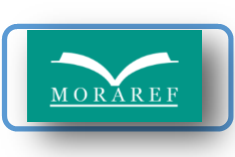The Effectiveness of Science Learning Media Using Focusky Software on Junior High School Students’ Higher Order Thinking Skills
(1) Department of Science Education, Postgraduate, Yogyakarta State University
(2) Department of Chemistry Education, Faculty of Mathematics and Science, Yogyakarta State Univeristy
(*) Corresponding Author
Abstract
This research aimed to identify the effectiveness of science learning media using focusky software on junior high school students’ High Order Thinking Skill (HOTS). Quasi-experiment is applied in pre-test – post-test non-equivalent control group design. The sampling technique applied wass cluster random sampling. Meanwhile, the instrument used was HOTS pre-test – post-test question. Data analysis techniques used were normality test, homogeneity test, Paired Sample T-test, Independent Sample T-test, and effect size. The result of this study indicates that the increase in HOTS of students in the experimental class was 50. It is higher than in the control class, which was only 30. The average post-test of the experimental class was 75.90, with 87% of students achieving the minimum criterion, while the average post-test of the control class was 60.25, with 75 % of students reach the minimum criterion. Based on the result of the Independent Sample T-test, it was shown that there were differences in HOTS abilities between the experimental class students and the control class students, and the effectiveness of the medium-sized learning media assisted by science learning media with an effect size of 0.7.
Keywords
Full Text:
PDFReferences
Abdullah, A. H., Mokhtar, M., Halim, N. D. A., Ali, D. F., Tahir, L. M., & Kohar, U. H. A. (2017). Mathematics Teachers' Level of Knowledge and Practice on the Implementation of Higher-Order Thinking Skills (HOTS). Eurasia Journal of Mathematics, Science & Technology Education, 13(1), 3-17. doi: 10.12973/eurasia.2017.00601a
Afandi, A., Junanto, T., & Afriani, R. (2016). Implementasi digital-age literacy dalam pendidikan abad 21 di Indonesia. In Prosiding SNPS (Seminar Nasional Pendidikan Sains) (Vol. 3, pp. 113-120), UNS Surakarta, Indonesia. Retrieved from http://jurnal.fkip.uns.ac.id/index.php/snps/article/download/9820/7255
Agustihana, S., & Suparno. (2018). The effectiveness of physics mobile learning media to improve higher order thinking skills of students in thermodynamics. In IOP Conf. Series: Journal of Physics: Conf. Series 1097, 012031, p. 1-9). IOP Publishing. doi: 10.1088/1742-6596/1097/1/012031
Ahyar, R., Lufri, L., & Sumarmin, R. (2014). Pengembangan multimedia pada materi struktur dan fungsi organ manusia untuk siswa kelas XI sekolah menengah atas. Kolaboratif, 2(1). 20-30.
Angreni, S. (2017). Pengaruh penggunaan media interaktif disertai LKS terhadap hasil belajar IPA pada kelas IX SMP. Scientiae Educatia: Jurnal Pendidikan Sains, 6(1), 36-40. doi: 10.24235/sc.educatia.v6i1.1293
Aripin, I. (2012). Penggunaan Multimedia Interaktif (MMI) untuk meningkatkan penguasaan konsep, berpikir kritis, dan retensi konsep sistem reproduksi manusia pada siswa SMA. Scientiae Educatia: Jurnal Pendidikan Sains, 1(2), 1-12. Retrieved from http://www.syekhnurjati.ac.id/jurnal/index.php/sceducatia/article/view/508/445
Carin, A. A. & Sund, R. B. (1989). Teaching science trough discovery. Columbus: Merrill Publishing Company
Chiappetta, E. L., & Koballa, T. R. (2010). Science Instruction in the middle and secondary schools: Developing fundamental knowledge and skills, 7th Edition. St. Louis: Pearson Education, inc.
Cohen, J. (1992). Quantitative methods in psychology. Psychological Bulletin, 112(1), 155-159. Retrieved from http://doi.apa.org/journals/bul/112/1/155/pdf
Fanani, A., & Kusmaharti, D. (2018). Pengembangan pembelajaran berbasis HOTS (higher order thinking skill) di sekolah dasar kelas V. Jurnal Pendidikan Dasar, 9(1), 1-11. doi: 10.21009/JPD.091.01
Fatahullah, M. M. (2016). Pengaruh media pembelajaran dan kemampuan berpikir kritis terhadap hasil belajar IPS. Jurnal Pendidikan Dasar UJN, 7(2), 237-252. Retrieved from http://pps.unj.ac.id/journal/jpd/article/view/383
Groff, J., Howells, C., & Cranmer, S. (2012). Console game-based pedagogy: A study of primary and secondary classroom learning through console video games. International Journal of Game-Based Learning (IJGBL), 2(2), 35-54. Retrieved from https://eric.ed.gov/?id=EJ1159925
Halah, A., A., & Patrick, M. (2015). 21st Century standards and curriculum: current research and practice. Journal of Education and Practice, 6(6), 150-154. Retrieved from https://files.eric.ed.gov/fulltext/EJ1083656.pdf
Hobbs, R., & Jensen, A. (2009). The past, present, and future of media literacy education. Journal of Media Literacy Education, 1(1), 1-11. Retrieved from https://files.eric.ed.gov/fulltext/EJ1095145.pdf
Husain, C., (2014). Pemanfaatan teknologi informasi dan komunikasi dalam pembelajaran di SMA Muhammadiyah Tarakan. Jurnal Kebijakan dan Pengembangan Pendidikan, 2(2), 184-192.
Idaharyani. (2017). Cara mudah membuat media pembelajaran interaktif dengan Focusky. Watampone: Syahadah
Jerome, C., Lee, J. A. C., & Ting, S. H. (2017). What students really need: instructional strategies that enhance higher order thinking skills (hots) among unimas undergraduates. International Journal of Business and Society, 18(S4), 661-668.
Jusoh, W. N. H., & Jusoff, K. (2009). Using multimedia in teaching Islamic studies. Journal of Media and Communication Studies, 1(5), 86-94.
Littlejohn, A., Margaryan, A., & Vojt, G. (2010). Exploring students' use of ICT and expectations of learning methods. Electronic Journal of e-learning, 8(1), 13-20.
Mahulae, P. S., Sirait, M., & Sirait, M. (2017). The effect of inquiry training learning model using phet media and scientific attitude on students’ science process skills. IOSR-Journal of Research & Method in Education, 7(5), 24-29. doi: 10.9790/7388-0705012429
Najmul, I., Cahya, E., & Nurjanah, N. (2017). Pembelajaran dengan pendekatan kontekstual berbantuan software focusky untuk meningkatkan kemampuan berpikir kritis dan disposisi matematis. Jurnal Penelitian Pendidikan, 17(3), 213-219. Retrieved from http://ejournal.upi.edu/index.php/JER/article/view/9615/5925
OECD. (2015). PISA 2015 results in focus. Draft OECD. Retrieved from https://www.oecd.org/pisa/pisa-2015-results-in-focus.pdf
Osman, K., & Hamid, S. H. A. (2009). Standard setting: inserting domain of the 21st century thinking skills into the existing science curriculum in Malaysia. Procedia-Social and Behavioral Sciences, 1(1), 2573-2577. doi:10.1016/j.sbspro.2009.01.454
Pretorius, L., van Mourik, G. P., & Barratt, C. (2017). Student choice and higher-order thinking: Using a novel flexible assessment regime combined with critical thinking activities to encourage the development of higher order thinking. International Journal of Teaching and Learning in Higher Education, 29(2), 389-401. Retrieved from https://files.eric.ed.gov/fulltext/EJ1146270.pdf
Raiyn, J. (2016). The role of visual learning in improving students’ high order thinking skills. Journal of Education and Practice, 7(24), 2222-2888. Retrieved from https://files.eric.ed.gov/fulltext/EJ1112894.pdf
Saido, G. M., Siraj, S., Nordin, A. B. B., & Al_Amedy, O. S. (2018). Higher order thinking skills among secondary school students in science learning. MOJES: Malaysian Online Journal of Educational Sciences, 3(3), 13-20. Retrieved from https://files.eric.ed.gov/fulltext/EJ1085914.pdf
Soh, T. M. T., Arsad, N. M., & Osman, K. (2010). The relationship of 21st century skills on students’ attitude and perception towards physics. Procedia-Social and Behavioral Sciences, 7(C), 546-554. doi:10.1016/j.sbspro.2010.10.073
Sugiyono. (2014). Metode penelitian pendidikan pendekatan kuantitatif, kualitatif, dan R & D. Bandung: Alfabeta
Sunarijah, Degeng, I. N. S., Ardhana, I. W., & Sulton. (2016). The effect of learning strategy and achievement motivation toward learning natural science outcome and scientific attitude at eight grade of junior high school. IOSR-Journal of Research & Method in Education, 6(2), 110-114. doi: 10.9790/7388-060201110114
Suryawati, E., & Osman, K. (2018). Contextual learning: innovative approach towards the development of students’ scientific attitude and natural science performance. Eurasia Journal of Mathematic, Science and Technology Education, 14(1), 1305-8223. doi: 10.12973/ejmste/79329
Syed, N., (2013). An effective use of ICT for education and learning by drawing on worldwide knowledge, research and experience: ICT as a change agent for education. Scholarly Journal of Education, 2(4), 38-45.
Tillery, E., & Ross. (2007). Integrated science. New York: McGraw Hill Companies
Trilling, B., & Fadel, C., (2009). 21st Century Skills: Learning For Life in Our Times. San Francisco: Jossey-Bas
Trowbridge, L. W., & Byebee, W. (1996). Becoming a secondary school science teacher. USA: Merrill Publishing Company
DOI: 10.24235/sc.educatia.v8i1.3886
Article Metrics
Abstract view : 352 timesPDF - 197 times
Refbacks
- There are currently no refbacks.
Scientiae Educatia: Jurnal Pendidikan Sains indexed by:

This work is licensed under a Creative Commons Attribution 4.0 International License.
Stat Counter (Link)

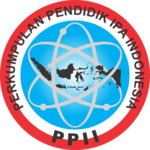

1.png)
